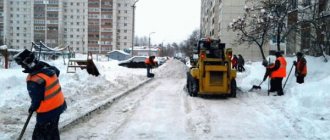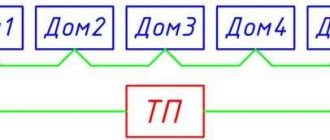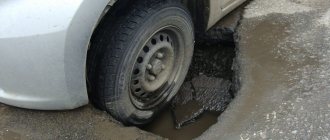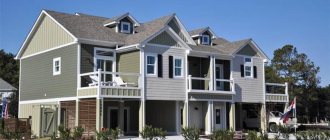What applies to the local area of an apartment building?
The adjacent territory is the common shared property of the residents of the house. It is a plot of land on which the apartment building itself and infrastructure facilities are located.
This is a single territory, therefore it is impossible to allocate a part of it for sale together with a separate apartment or to give it to the entrance.
According to, the local area includes:
- the plot of land on which the building is built;
- sports and children's playgrounds;
- elements of landscaping and improvement;
- clothes dryers;
- collective parking lots;
- heating points;
- fire passages;
- transformer substations;
- other objects that ensure normal operation of the house.
Residents can entrust the maintenance and repair of the local area to the house committee (independent management). If the building is under the management of the city, then she is responsible for landscaping the yard.
Yard boundaries
All MKD infrastructure facilities must be located within the local area. They, like area and other parameters, are reflected in the cadastral passport. The dimensions of the house plot are established taking into account:
- number of floors in the house;
- density of surrounding buildings;
- availability of public roads;
- area standards established for a given region.
Based on this information, the management company calculates the costs of cleaning the site.
All information about the territory and its borders is stored in several databases:
- in the State Real Estate Cadastre. All information is reflected on the public cadastral map, which is posted on the official website of Rosreestr. More detailed data can be found in the cadastral passport kept by the chairman of the house, the administration of the HOA or the management company;
- in the Unified Register of Real Estate Rights. The register contains data on the rights to the plot, its area, registration date and method of establishing boundaries.
Adjacent territory of an apartment building
The appearance of a new residential building, gas station or supermarket in the local area is a common occurrence. And this is happening due to the reduction of playgrounds and green recreation areas. The saddest thing is that residents cannot influence the situation in any way, even if they contact all the competent authorities. If, according to the law, the land does not belong to you, then someone else will manage it.
- the need to pay land tax;
- Only children's and sports grounds, as well as garages for disabled people and WWII participants, can be placed on the site:
- repairs and maintenance of the territory (including roads, internal driveways) are now carried out at the expense of the home owners.
We recommend reading: Revocation by the recoverer of the writ of execution from the bailiff service
Who is responsible for repairs and maintenance of the yard?
Who is responsible for the local area of the apartment building, its maintenance and service depends on whether the site has passed the registration and cadastral registration procedure.
When forming a plot of a house built before adoption (before March 1, 2005), apartment owners can submit an application for cadastral registration of the land and registration of ownership of it to state authorities or local government.
When new houses are built, the land underneath immediately becomes the property of the shareholders.
It is important to clarify whether the adjacent area has been formed with elements of infrastructure and landscaping. If not, apartment owners have the right to register ownership of it.
When transferring into common shared ownership, the territory on which the apartment building is located, the real estate objects included in it and the yard must go through the procedure of forming a land plot and be registered in the cadastral register.
At a general meeting, residents can decide whether to become the owners of the adjacent plot or leave it in municipal ownership
. Find out who is responsible for the maintenance and servicing of an apartment building and in what case.
Powers of the municipal administration
The territory on which apartment buildings and related infrastructure facilities are located does not always belong to the residents. Until a corresponding entry appears in the state cadastre and the boundaries of the yard are established, the municipality is considered the owner of the land plot. It is he who is given responsibility for the maintenance and repair of the site, regardless of the method of managing the apartment building.
In this case, it is not difficult to determine who is responsible for lighting in the courtyard of an apartment building or paving the paths - all this is the responsibility of the municipal administration.
When the management company or homeowners association responds
If all legal formalities are met and the adjacent territory is the property of the owners of apartments in the apartment building, they can independently carry out its improvement, monitor its maintenance and carry out repairs.
If an apartment building is managed by an HOA or management company, residents usually delegate these powers to them.
Find out in more detail what the rights and obligations of the HOA are regarding landscaping and repairs.
In the case where homeowners in an apartment building have signed a service agreement with the management company, it carries out the necessary restoration work. This is due to the fact that monthly payments include the costs of paying for services to maintain order within the local area.
Find out what the rights and responsibilities of the management company of apartment buildings are.

The legislative framework
The issues of establishing ownership of the local area, and, consequently, responsibility for its maintenance and repairs are regulated by the Housing Code of the Russian Federation (Articles 153, 154, 158) and (Article 210).
The belonging of the site to the common property of the owners and their obligation to finance work related to its improvement is stated in. This document introduced the Rules for maintaining the local area in an apartment building.
The list of landscaping and repair work is established in the rules and regulations for the operation of the housing stock, legalized.
What does asphalt paving work include?
As soon as the management company draws up an estimate and submits it to the residents for consideration, the latter will be able to familiarize themselves with the list of work that will be carried out by the contractors. Here is a list of standard actions that the vast majority of apartment building residents order:
- Laying asphalt around the perimeter of the structure. The width of the canvas is 1 meter, starting from the walls;
- Asphalting areas near entrances (width - about 5 meters);
- Covering parking lots where residents’ personal vehicles are located;
- Improvement of areas for sports and children's entertainment.
This is interesting: Documents for cutting off a plot of land
Despite the listed values, people can indicate their preferences in the contract, having previously agreed on them with the management company, so that the wishes do not lead to any disruptions in the functioning of engineering systems.
What work is being carried out in the local area?
Homeowners in apartment buildings, who pay monthly maintenance costs for common property, are usually interested in what is included in the maintenance of the local area of an apartment building.
According to the law, such work includes:
- installation of children's playgrounds;
- cleaning parking lots and courtyards;
- landscaping of yards;
- installation of waste collection tanks;
- installation of enclosing structures around the courtyard area;
- painting of landscaping elements;
- renovation of MKD territories.
Residents can initiate improvement work by submitting an application to the Criminal Code.
What is included in cleaning work
The concept of “cleaning the local area” includes seasonally clearing it of snow and leaves, sprinkling footpaths with anti-slip compounds during icy conditions.
Also, the management organization must control the timely removal of MSW from the territory.
Maintaining cleanliness and proper sanitary and hygienic conditions in the entrances and areas is the responsibility of the management company.
Cleaning of intra-block roads is carried out by specialized organizations, and first the sidewalks and pedestrian paths are cleared of debris, and then the roadway.
Yard landscaping
Green spaces play an important role in the design of the yard. They give an attractive appearance to the site and improve environmental performance.
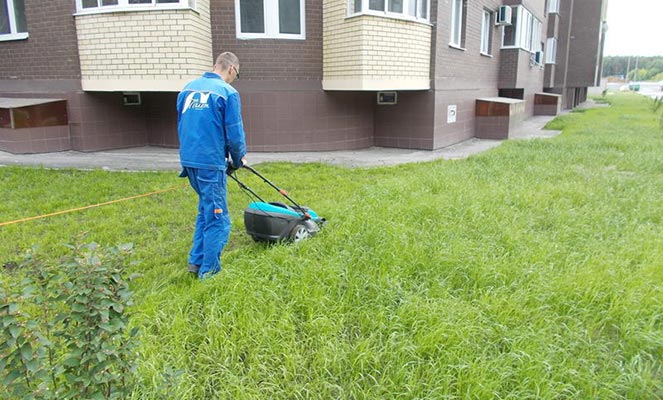
The rules for the technical operation of the housing stock contain the fundamental principles of landscaping measures:
- work is carried out only after the site has been cleared of construction debris and other waste;
- without special permission, it is strictly forbidden to cut down trees growing in the yard;
- when planting poplar and mulberry, it is not recommended to choose females, which cause more active clogging of areas;
- Every year, planned pest control of green spaces is organized.
There are special rules regarding green spaces that both management company employees and residents are required to follow. A large list of prohibitions is aimed at preventing damage to plants and preserving the yard area.
Laying asphalt
The poor condition of intra-block roads and sidewalks always raises the question among residents about who should repair the asphalt in the courtyard of an apartment building. The decision on the need to restore the asphalt surface should be made by the residents of the apartment building at a general meeting.
As a rule, the management company creates a special fund into which apartment owners contribute funds based on the calculated cost of the proposed work.
Additional fundraising for these purposes is due to the fact that the repair of roads in the courtyards of apartment buildings will be repaired by a contractor - an organization selected by the management company.
Road repairs must be carried out in compliance with SNiP recommendations for:
- the minimum permissible thickness of the asphalt layer is 0.15 m;
- the minimum width of asphalt around the house is 1 m;
- the use of fine-grained compounds;
- mandatory covering of paths leading to entrances and parking lots.
The fund can also be used to repair the sidewalk in the courtyard of an apartment building.
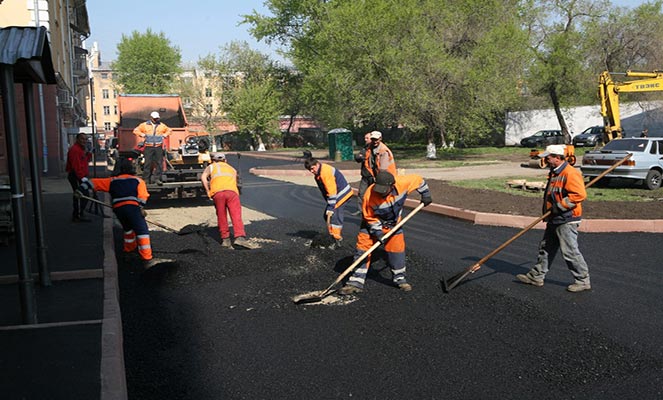
Installation of a barrier
The decision to install a barrier in the yard is taken by the general meeting of premises owners, since residents have the right to limit the use of the local area.
However, unauthorized installation of traffic lights, road signs and other means of organizing traffic, including barriers, is prohibited if they interfere with it. Therefore, to install a limiter, you must obtain permission from the city administration, agreed upon with the following services:
- communal;
- state fire supervision;
- Traffic police
At the general meeting, it is necessary to determine the rules for the entry of vehicles of residents and other persons into the yard.
Preparing the yard for seasonal use
The requirements for preparing the local area for seasonal use are listed in Gosstroy Decree No. 170. They contain a list of works that must be carried out by those responsible for its maintenance in the winter, for example:
- checking snow removal equipment and equipment;
- provision of sand and salt or its substitute for sprinkling during the period of icing of the ground, etc.
Other improvement activities
The improvement of the territory adjacent to the apartment buildings includes a number of other activities: the creation and maintenance of children's playgrounds in apartment buildings and parking lots. There are certain requirements for their arrangement. So, places for children's games should:
- correspond to different age groups of children;
- be located away from driveways and pedestrian paths;
- be located no closer than 20 m from garbage cans, parking lots, warehouses;
- be fenced off with green spaces that provide shade in the summer.
The management company is obliged to monitor compliance with sanitary standards: replace sand in the sandbox 1-2 times a year, ensure the cleanliness of the structures located on the site.
Stages of paving
For laying asphalt, it is recommended to choose dry weather with a positive temperature of ≥ 10 degrees.
The step-by-step procedure includes the following work:
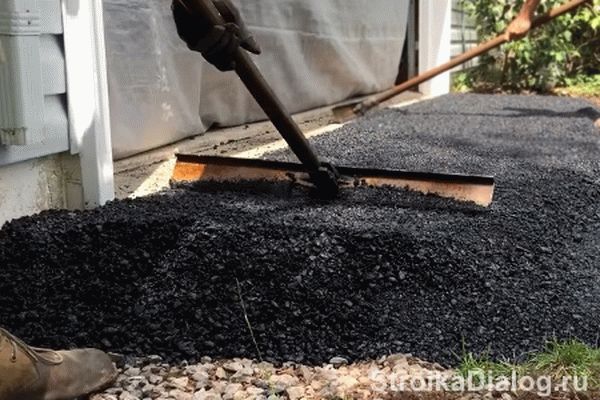
- On a sheet of graph paper, a diagram of the location of the house, outbuildings, paths to them, the area around the house and the passage for the car is drawn to scale. The roots of growing trees can deform the covering, so it is desirable that the trees are located at a distance of ≥ 2 m from the intended contours.
- Calculation of material requirements. It is recommended to cover the entire area with geotextiles with an overlap on the walls and cover it with a layer of sand 10 cm thick, crushed stone for the paths will be needed 5 cm thick, for the platform 15 cm, and directly for the driveway 25 cm, the number of enclosing elements is calculated according to the length of the contours, subject to asphalting. Asphalt will be required in the amount of 1 t per 10 m2 with a layer thickness of 5 cm; on driveways it is recommended to lay asphalt in two layers (5 plus 3 cm). The order is made for hot, fine-grained mixtures; sandy ones can be laid on the paths, but they are also hot.
- Prepare the following tools:
- a shovel for each worker;
- durable cord;
- mop-mop made of a meter-wide board with a handle 2.5 m long;
- a manual rammer, which is a piece of timber or round log with a square metal plate (20 cm side) fixed at the base and a handle in the form of a longitudinal wooden plank nailed on top;
- manual roller weighing ≥ 100 kg.
This is interesting: What documents are issued for a land plot?
To periodically lubricate the tool to prevent hot asphalt concrete from sticking to it, you will need a small amount of diesel fuel.
- Transferring the outlined contours to the terrain with wooden pegs.
- Excavation of soil to the depth of the listed layers with removal of roots of weeds, bushes and trees. The asphalt surface should be level with the surrounding surface of the earth or rise up to 5 cm (it all depends on the terrain and your desire). Base seal.
- Installation of curbs at the same level as the future asphalt concrete or 2...3 cm higher. First, curbs are installed along the edges of the path or area, leveled in height, a cord is pulled along which intermediate elements are laid out. Fixation of curbs is carried out using cement mortar and filling with compacted soil.
- Backfilling with sand, for effective compaction, wetting the sand cushion with water is used, laying geotextiles to reduce the pressing of crushed stone into the sand.
- Laying crushed stone with careful rolling with a roller. Larger fractions are placed downwards, and decluttering is carried out on top with smaller fractions. Compacted crushed stone is poured with bitumen mastic.
- The delivered asphalt is unloaded in separate piles. To prevent it from cooling down, the layout must be done quickly with the assistance of several assistants. Leveling is done using a motor mop. One person begins rolling the surface with a hand roller; to achieve greater effect, a person with a solid build can stand on the roller. With the provided transverse slopes, rolling is carried out from the bottom up. The movement of the roller should be smooth, without jerking. It is important to maintain the same number of passes on all lanes. It is unacceptable to stop the roller on areas that have not frozen to avoid sticking to the coating. In hard-to-reach places, the asphalt is compacted using hand compactors. We must not forget about the need to periodically wet the instruments with diesel fuel. If possible, it is recommended to roll most of the surface with large rollers or vibrating plates, available in specialized organizations. This will significantly increase the strength and quality of the laid coating.
- Finally, you can paint the entire asphalt area with special asphalt paints to obtain the required shades.
At this point the work can be considered completed.
Types of repairs to the local area
Maintaining the area around the apartment building in proper condition involves carrying out timely repair work.
The management company must carry out current and major repairs of the adjacent territory of an apartment building. Current repairs mean planned annual activities aimed at correcting damage and partially restoring elements of the apartment building itself and everything belonging to the owners of the site.
Find out in more detail what the rules are and what is included in the current renovation of an apartment building.
For a comprehensive restoration of structures or their complete replacement, a major overhaul is required. It is carried out as needed or upon request. The list of works of the management company for major repairs includes:
- restoration of fences;
- restoration of children's playgrounds;
- renovation of recreational facilities and others.
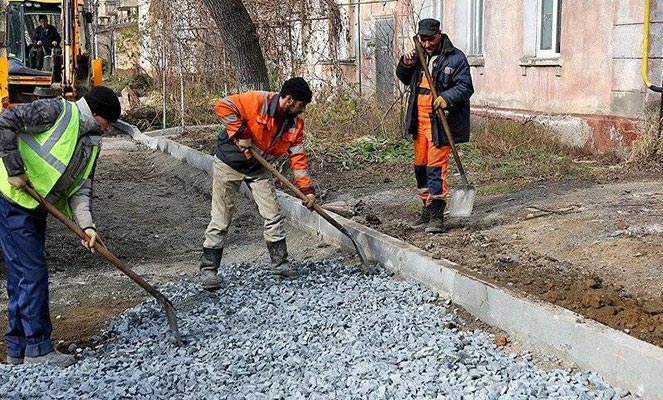
Find out how often it is carried out and what is included in the overhaul of apartment buildings.
Who Should Asphalt the Adjacent Territory of an Apartment Building
Let us remind you that according to Russian requirements for operational condition acceptable under the conditions of ensuring road safety, the dimensions of the holes should not exceed the following parameters: 15 cm in length, 5 cm in depth and 60 cm in width. Pits whose dimensions exceed one of the parameters must be marked and fenced in accordance with GOST 50597–93.
You can proceed to the final stage. Asphalt is applied to the base at a temperature of about 120 degrees with asphalt pavers and immediately rolled with rollers. In hard-to-reach places, all this is done using hand tools. Before applying the second layer of asphalt, the first one is coated with bitumen. To prevent water from forming puddles, the slopes of the finishing coating are calculated in advance and carefully observed during the entire process.
We recommend reading: Reduction factor for military pensioners in 2020
Who sets rates for yard maintenance?
Tariffing for services for the maintenance of land plots adjacent to apartment buildings is carried out by the utility organizations that provide them, and in some cases - by local government bodies.
The regulatory role in this matter is assigned to the state. It participates in pricing by adopting regulations:
- »;
- separate government resolutions.
Market factors have a significant impact on the cost of services: the level of inflation, prices for fuel and lubricants, wages and others. Tariffs may be revised annually.
Payment for maintenance of local areas is charged per square meter, taking into account the resident’s share in the common property. If the tariff rate is 10 rubles per 1 m2, and the area of the local area is 200 m2, then at a share of 3% the monthly fee for its maintenance is 60 rubles.
Find out in more detail what the tariffs for maintaining common property in an apartment building depend on.
Who to complain about poor quality service to?
The quality of services for maintaining the local area should always remain at a high level. This is especially true in winter, when snow drifts sometimes prevent you from even getting out of the house.
But service companies do not always cope with clearing yards and sidewalks of snow, removing household waste, or timely cleaning the site in the summer. In this case, the management company is obliged to revise payment tariffs.
The owners of the site send a written application for revision of tariffs no later than 6 months from the moment the violation was recorded.
If management officials do not respond to the claim with appropriate actions, homeowners in apartment buildings have the right to appeal to the Housing Inspectorate, the municipal administration, and even to court.
Find out more about where to complain about the management company.
Judicial practice in cases of challenging cleaning fees
The courts often receive claims from owners of apartments in apartment buildings challenging the established fee for cleaning the local area due to poor quality of the service. When making decisions, the courts, guided by the norms of Housing Legislation and decrees of the Government of the Russian Federation on this issue, often take the side of the plaintiffs.
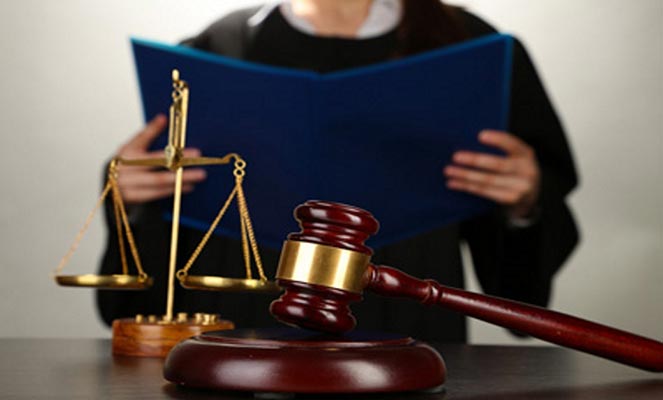
As judicial practice on the adjacent territories of apartment buildings shows, many controversial issues arise related to the establishment of boundaries, the lawful use and maintenance of courtyards. In each specific case, the court examines the arguments, evidence and other relevant information.


